PRACTICE PROBLEMS ON SPECIAL RIGHT TRIANGLES FOR SAT
Subscribe to our ▶️ YouTube channel 🔴 for the latest videos, updates, and tips.
Problem 1 :
In the figure given below, find the value of x.
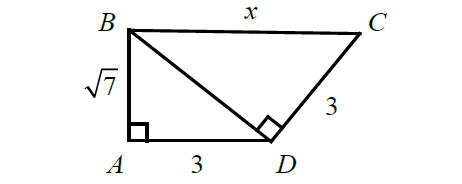
Solution :
In triangle ABD,
BD2 = AB2 + AD2
BD2 = √72 + 32
BD2 = 7 + 9
BD2 = 16
BD = 4
In triangle BDC,
BC2 = BD2 + DC2
x2 = 42 + 32
x2 = 16 + 9
x2 = 25
x = 5
Problem 2 :
In the figures below, find the values of x and y.
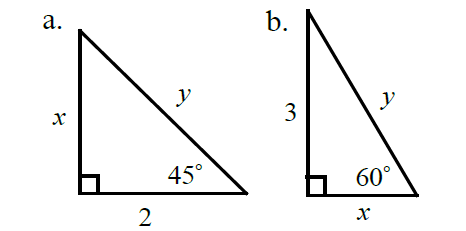
Solution :
(a) Since it is 45-45-90 triangle is an isosceles triangle, the value of x is 2.
In 45-45-90 right triangle, hypotenuse side = √2 ⋅ leg.
y = 2√2
(b) In a 30-60-90 right triangle,
longer leg = √3 ⋅ shorter leg
3 = √3 x
x = 3/√3
hypotenuse = 2⋅ shorter leg
y = 2x
y = 2(3/√3)
y = 2√3
Problem 3 :
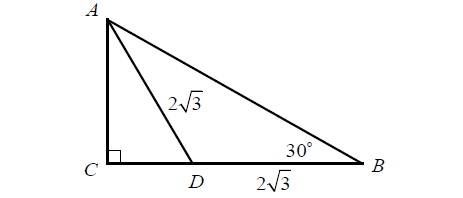
In the figure above, if AD = BD = 2√3, what is the length of AB?
Solution :
AD = BD = 2√3 (Given)
∠ADC = 30° + 30° (Using exterior angle theorem)
∠ADC = 60°
In triangle ADC,
∠CAD + ∠CDA + ∠ACD = 180°
∠CAD + 60° + 90° = 180°
∠CAD = 180°-150°
∠CAD = 30°
In triangle ACD, sine ∠CAD = 30°, its is a 30-60-90 triangle.
AD is hypotenuse and CD is the shorter leg.
hypotenuse (AD) = 2√3 (2 times the shorter leg)
CD = √3
The longer leg = (√3 times the shorter leg)
The longer leg(AC) = √3 √3
AC = 3
In triangle ABC,
BC = CD + BD
BC = √3 + 2√3 = 3√3
AB2 = AC2 + BC2
AB2 = 32 + (3√3)2
AB2 = 9 + 27
AB2 = 36
AB = 6
So, length of AB is 6.
Problem 4 :
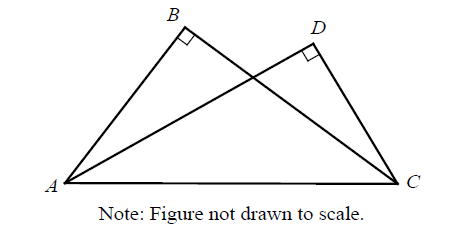
In the figure given above AB = 6, BC = 8 and CD = 5. What is the length of AD?
Solution :
In triangle ABC,
AC2 = AB2 + BC2
AC2 = 62 + 82
AC2 = 36 + 64
AC = 10
In triangle ADC,
AC2 = AD2 + DC2
102 = AD2 + 52
AD2 = 100 - 25
AD = √75
AD = 5√3
Problem 5 :
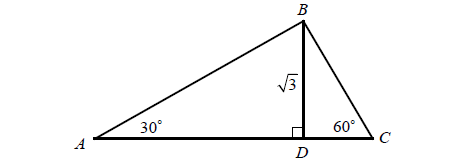
In the above triangle ABC, BD = √3. What is the perimeter of triangle ABC.
Solution :
In triangle BDC,
∠DBC = 30
The side which is opposite to smaller angle is shorter, then, let DC = x.
BC = (2 times the shorter leg) = 2x
BC2 = BD2 + DC2
(2x)2 = √32 + x2
3x2 = 3
x2 = 1
BC = 2(1)
= 2
DC = 1
In triangle ABD,
BD = √3 (Side which is opposite to smaller angle)
AB = 2√3
AB2 = AD2 + BD2
(2√3)2 =AD2+(√3)2
4(3) - 3 = AD2
12 - 3 = AD2
9 = AD2
3 = AD
CA = AD + DC
= 3 + 1
CA = 4
Perimeter of triangle ABC = AB + BC + CA
= 2√3 + 2 + 4
= 2√3 + 6
Problem 6 :
In the triangle above, ∠A ≅ ∠C and BD bisects AC. What is the perimeter of triangle ABC ?
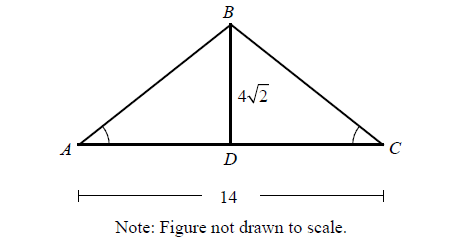
Solution :
Since BD is the bisector of AC,
AD = DC = 7
BD = 4√2
In triangle BDC,
BC2 = BD2 + DC2
BC2 = (4√2)2 + 72
BC2 = 16(2) + 49
BC2 = 81
BC = 9
AB = 9
Perimeter of triangle ABC = AB + BC + CA
= 9 + 9 + 14
= 32
Subscribe to our ▶️ YouTube channel 🔴 for the latest videos, updates, and tips.
Kindly mail your feedback to v4formath@gmail.com
We always appreciate your feedback.
About Us | Contact Us | Privacy Policy
©All rights reserved. onlinemath4all.com
Recent Articles
-
Specifying Units of Measure
Dec 15, 25 07:09 PM
Specifying Units of Measure -
Quantitative Reasoning Questions and Answers
Dec 14, 25 06:42 AM
Quantitative Reasoning Questions and Answers -
Coin Tossing Probability
Dec 13, 25 10:11 AM
Coin Tossing Probability - Concept - Sample Space - Formula - Solved Problems